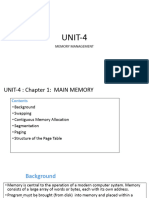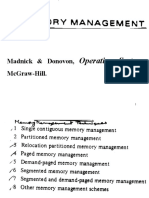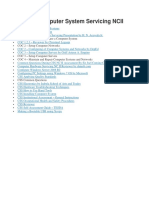Background - Swapping - Contiguous Allocation - Paging - Segmentation - Segmentation With Paging
Background - Swapping - Contiguous Allocation - Paging - Segmentation - Segmentation With Paging
Uploaded by
jrahulroyCopyright:
Available Formats
Background - Swapping - Contiguous Allocation - Paging - Segmentation - Segmentation With Paging
Background - Swapping - Contiguous Allocation - Paging - Segmentation - Segmentation With Paging
Uploaded by
jrahulroyOriginal Description:
Original Title
Copyright
Available Formats
Share this document
Did you find this document useful?
Is this content inappropriate?
Copyright:
Available Formats
Background - Swapping - Contiguous Allocation - Paging - Segmentation - Segmentation With Paging
Background - Swapping - Contiguous Allocation - Paging - Segmentation - Segmentation With Paging
Uploaded by
jrahulroyCopyright:
Available Formats
9.
Memory Management
• Background
• Swapping
• Contiguous Allocation
• Paging
• Segmentation
• Segmentation with Paging
Prof. D. S. R. Murthy OS-09 Memory Management 1
Background
• Program must be brought into memory and placed within a process for it to
be run.
• Input queue – collection of processes on the disk that are waiting to be
brought into memory to run the program.
• User programs go through several steps before being run.
Prof. D. S. R. Murthy OS-09 Memory Management 2
Binding of Instructions and Data to Memory
Address binding of instructions and data to memory addresses can happen
at three different stages.
• Compile time: If memory location known a priori, absolute code can be
generated; must recompile code if starting location changes.
• Load time: Must generate relocatable code if memory location is not known at
compile time.
• Execution time: Binding delayed until run time if the process can be moved
during its execution from one memory segment to another. Need hardware
support for address maps (e.g., base and limit registers).
Prof. D. S. R. Murthy OS-09 Memory Management 3
Multistep Processing of a User Program
Prof. D. S. R. Murthy OS-09 Memory Management 4
Logical vs. Physical Address Space
• The concept of a logical address space that is bound to a separate physical
address space is central to proper memory management.
– Logical address – generated by the CPU; also referred to as virtual
address.
– Physical address – address seen by the memory unit.
• Logical and physical addresses are the same in compile-time and load-time
address-binding schemes; logical (virtual) and physical addresses differ in
execution-time address-binding scheme.
Prof. D. S. R. Murthy OS-09 Memory Management 5
Memory-Management Unit (MMU)
• Hardware device that maps virtual to physical address.
• In MMU scheme, the value in the relocation register is added to every
address generated by a user process at the time it is sent to memory.
• The user program deals with logical addresses; it never sees the real
physical addresses.
Prof. D. S. R. Murthy OS-09 Memory Management 6
Dynamic relocation using a relocation register
Prof. D. S. R. Murthy OS-09 Memory Management 7
Dynamic Loading
• Routine is not loaded until it is called
• Better memory-space utilization; unused routine is never loaded.
• Useful when large amounts of code are needed to handle infrequently
occurring cases.
• No special support from the operating system is required implemented through
program design.
Prof. D. S. R. Murthy OS-09 Memory Management 8
Dynamic Linking
• Linking postponed until execution time.
• Small piece of code, stub, used to locate the appropriate memory-resident library
routine.
• Stub replaces itself with the address of the routine, and executes the routine.
• Operating system needed to check if routine is in processes’ memory address.
• Dynamic linking is particularly useful for libraries.
Prof. D. S. R. Murthy OS-09 Memory Management 9
Overlays
• Keep in memory only those instructions and data that are needed at any given
time.
• Needed when process is larger than amount of memory allocated to it.
• Implemented by user, no special support needed from operating system,
programming design of overlay structure is complex
Prof. D. S. R. Murthy OS-09 Memory Management 10
Overlays for a Two-Pass Assembler
Prof. D. S. R. Murthy OS-09 Memory Management 11
Swapping
• A process can be swapped temporarily out of memory to a backing store, and
then brought back into memory for continued execution.
• Backing store – fast disk large enough to accommodate copies of all memory
images for all users; must provide direct access to these memory images.
• Roll out, roll in – swapping variant used for priority-based scheduling
algorithms; lower-priority process is swapped out so higher-priority process can
be loaded and executed.
• Major part of swap time is transfer time; total transfer time is directly
proportional to the amount of memory swapped.
• Modified versions of swapping are found on many systems, i.e., UNIX, Linux,
and Windows.
Prof. D. S. R. Murthy OS-09 Memory Management 12
Schematic View of Swapping
Prof. D. S. R. Murthy OS-09 Memory Management 13
Contiguous Allocation
• Main memory usually into two partitions:
– Resident operating system, usually held in low memory with interrupt vector.
– User processes then held in high memory.
• Single-partition allocation
– Relocation-register scheme used to protect user processes from each other, and
from changing operating-system code and data.
– Relocation register contains value of smallest physical address; limit register
contains range of logical addresses – each logical address must be less than the
limit register.
Prof. D. S. R. Murthy OS-09 Memory Management 14
Hardware Support for Relocation and Limit Registers
Prof. D. S. R. Murthy OS-09 Memory Management 15
Contiguous Allocation (Cont.)
• Multiple-partition allocation
– Hole – block of available memory; holes of various size are scattered
throughout memory.
– When a process arrives, it is allocated memory from a hole large enough
to accommodate it.
– Operating system maintains information about:
a) allocated partitions b) free partitions (hole)
OS OS OS OS
process 5 process 5 process 5 process 5
process 9 process 9
process 8 process 10
process 2 process 2 process 2 process 2
Prof. D. S. R. Murthy OS-09 Memory Management 16
Dynamic Storage-Allocation Problem
How to satisfy a request of size n from a list of free holes.
• First-fit: Allocate the first hole that is big enough.
• Best-fit: Allocate the smallest hole that is big enough; must search entire
list, unless ordered by size. Produces the smallest leftover hole.
• Worst-fit: Allocate the largest hole; must also search entire list. Produces
the largest leftover hole.
First-fit and best-fit better than worst-fit in terms of speed and storage
utilization.
Prof. D. S. R. Murthy OS-09 Memory Management 17
Fragmentation
• External Fragmentation – total memory space exists to satisfy a request, but it is
not contiguous.
• Internal Fragmentation – allocated memory may be slightly larger than
requested memory; this size difference is memory internal to a partition, but not
being used.
• Reduce external fragmentation by compaction
– Shuffle memory contents to place all free memory together in one large block.
– Compaction is possible only if relocation is dynamic, and is done at execution
time.
– I/O problem
• Latch job in memory while it is involved in I/O.
• Do I/O only into OS buffers.
Prof. D. S. R. Murthy OS-09 Memory Management 18
Paging
• Logical address space of a process can be noncontiguous; process is allocated
physical memory whenever the latter is available.
• Divide physical memory into fixed-sized blocks called frames (size is power of 2,
between 512 bytes and 8192 bytes).
• Divide logical memory into blocks of same size called pages.
• Keep track of all free frames.
• To run a program of size n pages, need to find n free frames and load program.
• Set up a page table to translate logical to physical addresses.
• Internal fragmentation.
Prof. D. S. R. Murthy OS-09 Memory Management 19
Address Translation Scheme
• Address generated by CPU is divided into:
– Page number (p) – used as an index into a page table which contains
base address of each page in physical memory.
– Page offset (d) – combined with base address to define the physical
memory address that is sent to the memory unit.
Prof. D. S. R. Murthy OS-09 Memory Management 20
Address Translation Architecture
Prof. D. S. R. Murthy OS-09 Memory Management 21
Paging Example
Prof. D. S. R. Murthy OS-09 Memory Management 22
Paging Example
Prof. D. S. R. Murthy OS-09 Memory Management 23
Free Frames
Before allocation After allocation
Prof. D. S. R. Murthy OS-09 Memory Management 24
Implementation of Page Table
• Page table is kept in main memory.
• Page-table base register (PTBR) points to the page table.
• Page-table length register (PRLR) indicates size of the page table.
• In this scheme every data/instruction access requires two memory accesses.
One for the page table and one for the data/instruction.
• The two memory access problem can be solved by the use of a special fast-
lookup hardware cache called associative memory or translation look-aside
buffers (TLBs)
Prof. D. S. R. Murthy OS-09 Memory Management 25
Associative Memory
• Associative memory – parallel search
Page # Frame #
Address translation (A´, A´´)
– If A´ is in associative register, get frame # out.
– Otherwise get frame # from page table in memory
Prof. D. S. R. Murthy OS-09 Memory Management 26
Paging Hardware With TLB
Prof. D. S. R. Murthy OS-09 Memory Management 27
Effective Access Time
• Associative Lookup = time unit
• Assume memory cycle time is 1 microsecond
• Hit ratio – percentage of times that a page number is found in the associative
registers; ration related to number of associative registers.
• Hit ratio =
• Effective Access Time (EAT)
EAT = (1 + ) + (2 + )(1 – )
=2+–
Prof. D. S. R. Murthy OS-09 Memory Management 28
Memory Protection
• Memory protection implemented by associating protection bit with each
frame.
• Valid-invalid bit attached to each entry in the page table:
– “valid” indicates that the associated page is in the process’ logical
address space, and is thus a legal page.
– “invalid” indicates that the page is not in the process’ logical address
space.
Prof. D. S. R. Murthy OS-09 Memory Management 29
Valid (v) or Invalid (i) Bit In A Page Table
Prof. D. S. R. Murthy OS-09 Memory Management 30
Page Table Structure
• Hierarchical Paging
• Hashed Page Tables
• Inverted Page Tables
Prof. D. S. R. Murthy OS-09 Memory Management 31
Hierarchical Page Tables
• Break up the logical address space into multiple page tables.
• A simple technique is a two-level page table.
Prof. D. S. R. Murthy OS-09 Memory Management 32
Two-Level Paging Example
• A logical address (on 32-bit machine with 4K page size) is divided into:
– a page number consisting of 20 bits.
– a page offset consisting of 12 bits.
• Since the page table is paged, the page number is further divided into:
– a 10-bit page number.
– a 10-bit page offset.
• Thus, a logical address is as follows:
page number page offset
where pi is an index into the outer
pi pageptable, and p2 is the displacement within the page of the
outer page table.
2 d
10 10 12
Prof. D. S. R. Murthy OS-09 Memory Management 33
Two-Level Page-Table Scheme
Prof. D. S. R. Murthy OS-09 Memory Management 34
Address-Translation Scheme
• Address-translation scheme for a two-level 32-bit paging architecture
Prof. D. S. R. Murthy OS-09 Memory Management 35
Hashed Page Tables
• Common in address spaces > 32 bits.
• The virtual page number is hashed into a page table.
This page table contains a chain of elements hashing to the same location.
• Virtual page numbers are compared in this chain searching for a match.
If a match is found, the corresponding physical frame is extracted.
Prof. D. S. R. Murthy OS-09 Memory Management 36
Hashed Page Table
Prof. D. S. R. Murthy OS-09 Memory Management 37
Inverted Page Table
• One entry for each real page of memory.
• Entry consists of the virtual address of the page stored in that real memory
location, with information about the process that owns that page.
• Decreases memory needed to store each page table, but increases time needed to
search the table when a page reference occurs.
• Use hash table to limit the search to one — or at most a few — page-table entries.
Prof. D. S. R. Murthy OS-09 Memory Management 38
Inverted Page Table Architecture
Prof. D. S. R. Murthy OS-09 Memory Management 39
Shared Pages
• Shared code
– One copy of read-only (reentrant) code shared among processes
(i.e., text editors, compilers, window systems).
– Shared code must appear in same location in the logical address space of
all processes.
• Private code and data
– Each process keeps a separate copy of the code and data.
– The pages for the private code and data can appear anywhere in the logical
address space.
Prof. D. S. R. Murthy OS-09 Memory Management 40
Shared Pages Example
Prof. D. S. R. Murthy OS-09 Memory Management 41
Segmentation
• Memory-management scheme that supports user view of memory.
• A program is a collection of segments.
A segment is a logical unit such as:
main program,
procedure,
function,
method,
object,
local variables, global variables,
common block,
stack,
symbol table, arrays
Prof. D. S. R. Murthy OS-09 Memory Management 42
User’s View of a Program
Prof. D. S. R. Murthy OS-09 Memory Management 43
Logical View of Segmentation
4
1
3 2
4
user space physical memory space
Prof. D. S. R. Murthy OS-09 Memory Management 44
Segmentation Architecture
• Logical address consists of a two tuple:
<segment-number, offset>,
• Segment table – maps two-dimensional physical addresses; each table entry has:
– base – contains the starting physical address where the segments reside in memory.
– limit – specifies the length of the segment.
• Segment-table base register (STBR)
points to the segment table’s location in memory.
• Segment-table length register (STLR)
indicates number of segments used by a program;
segment number s is legal if s < STLR.
Prof. D. S. R. Murthy OS-09 Memory Management 45
Segmentation Architecture (Cont.)
• Relocation.
– dynamic
– by segment table
• Sharing.
– shared segments
– same segment number
• Allocation.
– first fit/best fit
– external fragmentation
Prof. D. S. R. Murthy OS-09 Memory Management 46
Segmentation Architecture (Cont.)
• Protection. With each entry in segment table associate:
– validation bit = 0 illegal segment
– read/write/execute privileges
• Protection bits associated with segments; code sharing occurs at segment level.
• Since segments vary in length, memory allocation is a dynamic storage-allocation
problem.
Prof. D. S. R. Murthy OS-09 Memory Management 47
Example of Segmentation
Prof. D. S. R. Murthy OS-09 Memory Management 48
Segmentation Hardware
Prof. D. S. R. Murthy OS-09 Memory Management 49
Sharing of Segments
Prof. D. S. R. Murthy OS-09 Memory Management 50
Segmentation with Paging – MULTICS
• The MULTICS system solved problems of external fragmentation and lengthy
search times by paging the segments.
• Solution differs from pure segmentation in that the segment-table entry contains
not the base address of the segment, but rather the base address of a page table
for this segment.
Prof. D. S. R. Murthy OS-09 Memory Management 51
MULTICS Address Translation Scheme
Prof. D. S. R. Murthy OS-09 Memory Management 52
Segmentation with Paging – Intel 386
• Intel 386 uses segmentation with paging for memory management with a two-level
paging scheme.
Prof. D. S. R. Murthy OS-09 Memory Management 53
Intel 30386 Address Translation
Prof. D. S. R. Murthy OS-09 Memory Management 54
You might also like
- Lecture 06Document70 pagesLecture 06Sen HouNo ratings yet
- UNIT IV - Compatibility ModeDocument77 pagesUNIT IV - Compatibility ModeRudraksh sahNo ratings yet
- Lecture 11Document12 pagesLecture 11api-3801184No ratings yet
- Unit-Iv: Memory ManagementDocument19 pagesUnit-Iv: Memory ManagementSainiNishrithNo ratings yet
- Spos Unit 6Document133 pagesSpos Unit 6lokeshpatil977No ratings yet
- CH 5Document44 pagesCH 5UuiiNo ratings yet
- Main MemoryDocument50 pagesMain MemoryStanikzaiNo ratings yet
- 9 Memory Management StrategiesDocument59 pages9 Memory Management StrategiesShradha SwarupNo ratings yet
- Memory Management: Background Swapping Contiguous Allocation Paging Segmentation Segmentation With PagingDocument55 pagesMemory Management: Background Swapping Contiguous Allocation Paging Segmentation Segmentation With PagingsumipriyaaNo ratings yet
- Main Memory: Basic HardwareDocument16 pagesMain Memory: Basic HardwareHarshith BejjamNo ratings yet
- MMGMNT PDFDocument55 pagesMMGMNT PDFalihamzaNo ratings yet
- Unit 4-Memory MaangementDocument15 pagesUnit 4-Memory MaangementHabtieNo ratings yet
- UNIT IV Memory Management - POS - 20a05605a - ECE - III - IIDocument47 pagesUNIT IV Memory Management - POS - 20a05605a - ECE - III - IIrakeshluddu042No ratings yet
- OS R19 - UNIT-3 (Ref-2)Document40 pagesOS R19 - UNIT-3 (Ref-2)Jay PrakashNo ratings yet
- ICS 143 - Principles of Operating SystemsDocument52 pagesICS 143 - Principles of Operating SystemsVijay Vikram SinghNo ratings yet
- Memory Management: Paging and SegmentationDocument71 pagesMemory Management: Paging and SegmentationWEBSITE NINJANo ratings yet
- Unit-1Document46 pagesUnit-1ipscr.mansiNo ratings yet
- 07 Main MemoryDocument80 pages07 Main MemoryBùi Đức HảiNo ratings yet
- Os Unit IiiDocument50 pagesOs Unit IiiSaitamaNo ratings yet
- Unit-2 OS Ch-1 CompleteDocument18 pagesUnit-2 OS Ch-1 CompleteVaibhavNo ratings yet
- Lecture Memory RemovedDocument33 pagesLecture Memory RemovedMohamad YassineNo ratings yet
- Lecture MemoryDocument55 pagesLecture MemoryMohamad YassineNo ratings yet
- Wa0012Document65 pagesWa0012Naeem AhmedNo ratings yet
- ch09 Main MemoryDocument51 pagesch09 Main Memorytmdgn0214No ratings yet
- Chapter Five - Memory ManagmentpDocument57 pagesChapter Five - Memory ManagmentpThe True TomNo ratings yet
- Operating Systems Notes: 1. What Is An OS (P5)Document34 pagesOperating Systems Notes: 1. What Is An OS (P5)Jordas AndreiNo ratings yet
- Memory ManagementDocument57 pagesMemory Management1nshsankritNo ratings yet
- Os Chap3Document13 pagesOs Chap3Mohammad AhmadNo ratings yet
- Unit 4 NotesDocument36 pagesUnit 4 NotesHare Ram SinghNo ratings yet
- Chapter 3 OSDocument33 pagesChapter 3 OSamanterefe99No ratings yet
- Computer OrganizationDocument34 pagesComputer OrganizationGhumti Duniyan superstarsNo ratings yet
- Memory ManagementDocument27 pagesMemory Managementimrank39199No ratings yet
- MemoryManagement PDFDocument44 pagesMemoryManagement PDFalihamzaNo ratings yet
- Chapter-7 - Main MemoryDocument62 pagesChapter-7 - Main MemoryAsad KhanNo ratings yet
- Oslecture10 13Document160 pagesOslecture10 1323-Shruti GunjkarNo ratings yet
- Unit 3 MemoryManagementDocument15 pagesUnit 3 MemoryManagementlokaprasaad.v.sNo ratings yet
- CS1120 - Principles of Operating Systems: Lectures 10,11,12 And13 - Memory Management Mr. Rowan N. ElominaDocument83 pagesCS1120 - Principles of Operating Systems: Lectures 10,11,12 And13 - Memory Management Mr. Rowan N. ElominaMelvin LeyvaNo ratings yet
- Ex 8Document54 pagesEx 8rahul_agrawal165No ratings yet
- Main MemoryDocument54 pagesMain MemoryRohit PaulNo ratings yet
- OS NotesDocument79 pagesOS NotesSawn HotNo ratings yet
- OS Unit 5-MemoryDocument60 pagesOS Unit 5-Memorydeathstar3jediNo ratings yet
- Ch. 3 Lecture 1 - 3 PDFDocument83 pagesCh. 3 Lecture 1 - 3 PDFmikiasNo ratings yet
- Os Unit-4 Chapter-1Document68 pagesOs Unit-4 Chapter-1spittymedevinNo ratings yet
- ICS 431 Ch9 Memory ManagementDocument83 pagesICS 431 Ch9 Memory ManagementThe Great HammerNo ratings yet
- Cs8493 Operating System 3Document37 pagesCs8493 Operating System 3alexb072002No ratings yet
- Unit IV CAL 817 Operating SystemDocument17 pagesUnit IV CAL 817 Operating SystemRAZEB PATHANNo ratings yet
- Unit 4aDocument104 pagesUnit 4aKoushik ThummalaNo ratings yet
- Chapter-8 (Memory Management)Document42 pagesChapter-8 (Memory Management)Ar. RajaNo ratings yet
- Chapter 3Document45 pagesChapter 3Eyasu SewalemNo ratings yet
- Main MemoryDocument63 pagesMain MemoryNIDHINo ratings yet
- ICS 143 - Principles of Operating SystemsDocument83 pagesICS 143 - Principles of Operating SystemsManoj SharmaNo ratings yet
- OS - Lect 5Document43 pagesOS - Lect 5aehab1912No ratings yet
- Unit 4Document208 pagesUnit 4Kedhar NadhNo ratings yet
- 9 OS Memory 1Document25 pages9 OS Memory 1hasnaatdon1No ratings yet
- 20AIM52A Module 4Document130 pages20AIM52A Module 4Google PixalNo ratings yet
- Unit-3 Os NotesDocument33 pagesUnit-3 Os Noteslinren2005No ratings yet
- Memory ManagementDocument127 pagesMemory ManagementGlrmnNo ratings yet
- Lecture5 - Memory - Management - PPTX Filename - UTF-8''Lecture5 - Memory ManagementDocument90 pagesLecture5 - Memory - Management - PPTX Filename - UTF-8''Lecture5 - Memory ManagementMariyam AshrafNo ratings yet
- Unit 3Document87 pagesUnit 3devileela921No ratings yet
- Computer Science: Learn about Algorithms, Cybersecurity, Databases, Operating Systems, and Web DesignFrom EverandComputer Science: Learn about Algorithms, Cybersecurity, Databases, Operating Systems, and Web DesignNo ratings yet
- Os 08Document32 pagesOs 08jrahulroyNo ratings yet
- Operating Systems: Madnick & Donovon,, Mcgraw-HillDocument20 pagesOperating Systems: Madnick & Donovon,, Mcgraw-HilljrahulroyNo ratings yet
- Background Critical-Section Problem Semaphores Classical Problems of Synchronization MonitorsDocument32 pagesBackground Critical-Section Problem Semaphores Classical Problems of Synchronization MonitorsjrahulroyNo ratings yet
- Prof. D.S.R. Murthy OS-6 CPU Scheduling 1Document23 pagesProf. D.S.R. Murthy OS-6 CPU Scheduling 1jrahulroyNo ratings yet
- Os 04Document33 pagesOs 04jrahulroyNo ratings yet
- Multithreading Models Threading Issues Pthreads Solaris 2 Threads Windows 2000 Threads Linux Threads Java ThreadsDocument23 pagesMultithreading Models Threading Issues Pthreads Solaris 2 Threads Windows 2000 Threads Linux Threads Java ThreadsjrahulroyNo ratings yet
- Operating System StructuresDocument50 pagesOperating System StructuresjrahulroyNo ratings yet
- Os 01Document36 pagesOs 01jrahulroyNo ratings yet
- Knowledge Representation and ReasoningDocument20 pagesKnowledge Representation and ReasoningjrahulroyNo ratings yet
- BCS402Document2 pagesBCS402adibamomin740No ratings yet
- Sarana Dan Prasarana Pengadaan SIM RS Rumkital Dr. OepomoDocument4 pagesSarana Dan Prasarana Pengadaan SIM RS Rumkital Dr. OepomoanggarayudistiraNo ratings yet
- PC Technical Reference Aug81Document396 pagesPC Technical Reference Aug81kgrhoadsNo ratings yet
- Windows7 PC 2Document5 pagesWindows7 PC 2Okezi AkpokeneNo ratings yet
- Reg No: 2002/003562/23 VAT No: 4910205568 Tel No: 0829387551 E-MailDocument1 pageReg No: 2002/003562/23 VAT No: 4910205568 Tel No: 0829387551 E-MailNad KewlNo ratings yet
- Recommended Psu TableDocument2 pagesRecommended Psu TableRamdanul BarkahNo ratings yet
- 01 TE Arsikom2Document28 pages01 TE Arsikom2FSArifNo ratings yet
- ArubaOS Virtual Appliance VM Requirements 1Document7 pagesArubaOS Virtual Appliance VM Requirements 1heddaNo ratings yet
- Desktop Energy Consumption: A Comparison of Thin Clients and PcsDocument7 pagesDesktop Energy Consumption: A Comparison of Thin Clients and PcsGangaNo ratings yet
- Intel® Desktop Compatibility Tool: Intel® High End Desktop I7-3960X - Frequency: 3.30 GHZDocument4 pagesIntel® Desktop Compatibility Tool: Intel® High End Desktop I7-3960X - Frequency: 3.30 GHZVictorNo ratings yet
- Assembley Langauge and Instuction Set of 8051Document48 pagesAssembley Langauge and Instuction Set of 8051Juhi TiwariNo ratings yet
- TESDA Computer System Servicing NCIIDocument1 pageTESDA Computer System Servicing NCIIRo'yhen OconraNo ratings yet
- Huawei Server Portfolio-V5-EnglishDocument1 pageHuawei Server Portfolio-V5-EnglishAdhu AdharshNo ratings yet
- 8085 Addressing Modes: Dayanand KDocument16 pages8085 Addressing Modes: Dayanand KBhavya Babu100% (1)
- Acer TravelMate 7230 - 7530 Quanta ZY7 Rev1A SchematicDocument36 pagesAcer TravelMate 7230 - 7530 Quanta ZY7 Rev1A Schematicslawek wieczorekNo ratings yet
- Device Drivers PDFDocument28 pagesDevice Drivers PDF2015mdaamir2015100% (1)
- Scsiflash-2 - User - Guide Rev QDocument30 pagesScsiflash-2 - User - Guide Rev QMiguel50% (2)
- The Universal Serial Bus: Part 2: Transfers and DriversDocument5 pagesThe Universal Serial Bus: Part 2: Transfers and Driverslaszlo1231No ratings yet
- HP 8570p UMA 2012 PDFDocument66 pagesHP 8570p UMA 2012 PDFjules eyapNo ratings yet
- Information and Communication TechnologyDocument33 pagesInformation and Communication Technologyashodhiya14No ratings yet
- Compaq nx8220Document216 pagesCompaq nx8220denz07No ratings yet
- KS3 Answer Sheet - 01 Introduction To ComputersDocument7 pagesKS3 Answer Sheet - 01 Introduction To ComputersMugerwa CharlesNo ratings yet
- StarBoard FX 79E2 Oct2021Document2 pagesStarBoard FX 79E2 Oct2021pauloNo ratings yet
- CD 00158241Document81 pagesCD 00158241hschoiNo ratings yet
- Device Mapping On Sun Servers - A Quick GuideDocument7 pagesDevice Mapping On Sun Servers - A Quick GuideAnas MSNo ratings yet
- Interactive Technology Magazine TemplateDocument16 pagesInteractive Technology Magazine TemplateKanishk SinghNo ratings yet
- Driveri Asus XPDocument4 pagesDriveri Asus XPSavo MihaiNo ratings yet
- Multi Core ProcessorDocument11 pagesMulti Core ProcessorAnonymous Wu14iV9dqNo ratings yet
- IM Intro To ICT Part 2Document68 pagesIM Intro To ICT Part 2Maureen Li GuingabNo ratings yet
- CAO Lab Manual 22092020 063654pm PDFDocument52 pagesCAO Lab Manual 22092020 063654pm PDFPaul WalkerNo ratings yet


































































































